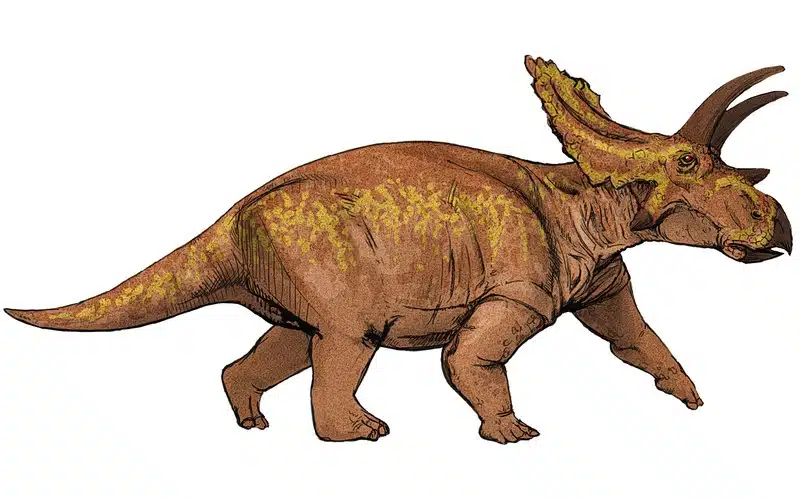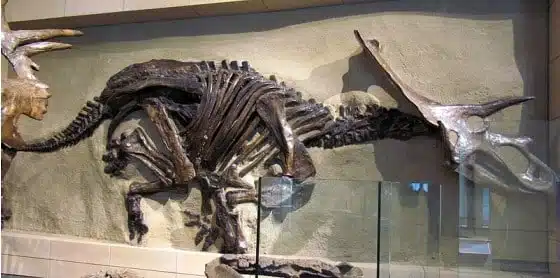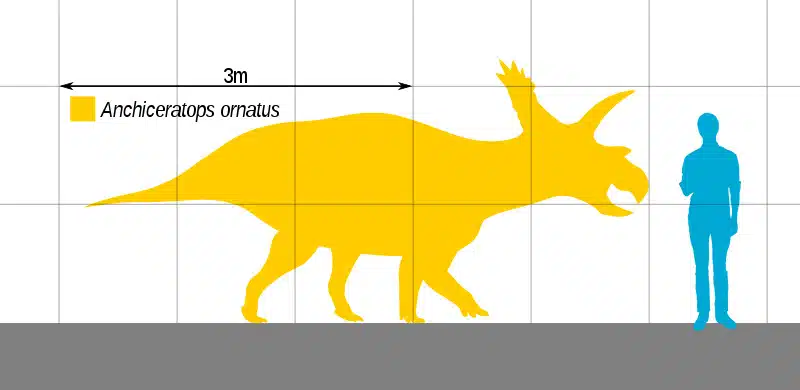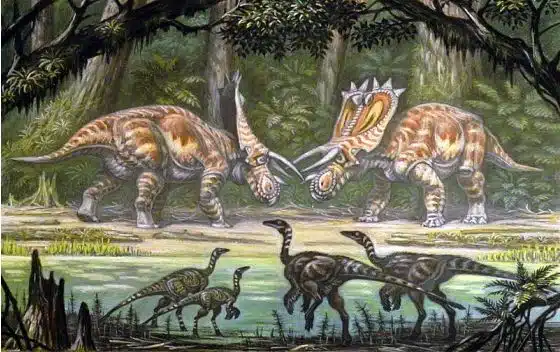Take a journey back in time, some 70 million years ago to the Late Cretaceous period. The world is a vastly different place, teeming with life forms that are both fascinating and terrifying. Among these ancient creatures one stands out for its unique features and intriguing history– Anchiceratops.
This dinosaur, whose name means ‘near horned face’, is a captivating subject of study for paleontologists and dinosaur enthusiasts alike. Its story, like that of all dinosaurs, is a tale of survival, adaptation, and ultimately–extinction. But what makes the Anchiceratops particularly interesting? Let’s delve into its world and find out.
Anchiceratops Key Facts
| Keyword | Fact |
|---|---|
| Anchiceratops pronunciation | an-key-SERRA-tops |
| Meaning of name | Near horned face |
| Group | Ceratopsia |
| Type Species | Anchiceratops ornatus |
| Diet | Herbivore |
| When it Lived | 70.6 to 66.0 MYA |
| Period | Late Cretaceous |
| Epoch | Early/Lower Maastrichtian |
| Length | 14.0 to 20.0 ft |
| Height | 6.9 ft |
| Weight | 1.3 tons |
| Mobility | Moved on all four |
| First Discovery | 1912 by Barnum Brown-led expedition |
| Location of first find | Alberta, Canada |
| First Described by | 1914 by Barnum Brown |
| Holotype | AMNH 5251 |
Anchiceratops Taxonomy and Timeline

The name Anchiceratops is derived from the Greek words “anchi” meaning “near”, “keras” meaning “horn”, and “ops” meaning “face”. This is a fascinating dinosaur that roamed the Earth during the Late Cretaceous period. Its name gives us a hint about its physical characteristics–particularly its distinctive horns.
Belonging to the Ceratopsia group, a family of herbivorous dinosaurs known for their beaked faces and frilled skulls, the Anchiceratops is a member of the Ceratopsidae family. The type species of this dinosaur is Anchiceratops ornatus.
The timeline is situated in the Late Cretaceous period, specifically the Early/Lower Maastrichtian epoch. This places the existence of this dinosaur in a time when the Earth was undergoing significant geological and climatic changes.
Listen to Pronunciation
Discovery & Fossil Evidence
The first discovery was made in 1912 in Alberta, Canada by the renowned paleontologist Barnum Brown. Brown, who is credited with numerous dinosaur discoveries, described the Anchiceratops for the first time in 1914. The holotype–or the specimen used to describe the species–is known as AMNH 5251.

Since the initial discovery, several other fossils have been found, primarily in Canada. In fact, seven additional finds have been reported in Alberta that provide valuable insights into the physical characteristics and lifestyle of this dinosaur. These fossils include skull and skeletal fragments that have helped paleontologists piece together a more comprehensive picture of this herbivorous dinosaur.
Anchiceratops Size and Description
Like other members of the Ceratopsia group, this was a quadrupedal dinosaur that moved on all four legs. Its physical features were distinctive yet typical of ceratopsid dinosaurs–a large frill, a beaked face, and prominent horns.
This was a large dinosaur with a robust body, a long tail, and a heavy build. Its head was adorned with a large frill that was likely used for display or defense. The dinosaur also had two large horns above its eyes and a smaller horn on its nose. Its beak was sharp and strong, ideal for breaking down plant material.
Size and Weight of Type Species

Based on the current available fossils, researchers have estimated the size and weight of the Anchiceratops. The length is estimated to range from 14.0 to 20.0 feet, the height is thought to be around 6.9 feet, and the dinosaur is believed to have weighed approximately 1.3 tons. These figures make Anchiceratops a medium size dinosaur, comparable in size to other ceratopsids, though these estimates may be refined as more information becomes available.
The Dinosaur in Detail
With its distinctive horns and large frill, it is a testament to the incredible diversity of life during the Late Cretaceous period. Its unique features not only set it apart from other dinosaurs but also provide insights into its behavior and lifestyle.
One of the most striking features of Anchiceratops is its large frill. This bony structure, which extended from the back of the skull, was likely used for display purposes, possibly to attract mates or intimidate rivals. The frill may also have served a defensive function, protecting the dinosaur’s neck from predators.
The horns of Anchiceratops are another notable feature. The dinosaur had two large horns above its eyes and a smaller horn on its nose. These horns were likely used for defense against predators. They may also have been used in combat with other Anchiceratops, possibly over territory or mates.
Anchiceratops was a herbivore, feeding on a diet of plants. Its sharp beak and strong jaws would have allowed it to break down tough plant material. The dinosaur’s teeth were continually replaced throughout its life, ensuring that it always had a fresh set of teeth for grinding down food.
Anchiceratops in its Natural Habitat

Anchiceratops lived during the Late Cretaceous period, a time when the Earth was warmer than it is today. It made its home on the paleocontinent Laramidia–what is now the western half of North America. The environment would have been lush and verdant with a diverse array of plant life. This would have provided ample food for the herbivorous Anchiceratops.
It likely moved in herds and used its large frill and horns for defense against predators. Its strong beak and continually replacing teeth would have allowed it to break down tough plant material, making it well adapted to its environment.
It was a quadrupedal dinosaur like many of its ceratopsid relatives. This would have given it stability and strength and allowed it to navigate its environment effectively. Its large size and robust build would have made it a formidable presence in its habitat.
Interesting Points about Anchiceratops
- This dinosaur had a pair of large, prominent horns above its eyes. This gave it the name, which means ‘near horned face’.
- It lived during the Late Cretaceous period, which was the last period of the Mesozoic Era and often referred to as the ‘Age of Dinosaurs’.
- This was an herbivore, feeding on a diet of plants. This is in contrast to many other large dinosaurs of the time, which were carnivores.
- The first fossil was discovered in Alberta, Canada–a region known for its rich dinosaur fossil record.
- A smaller skull was once attributed to a subspecies, Anchiceratops longirostris, but this was later changed by paleontologists and only the type species is currently recognized.
Contemporary Dinosaurs
In the late Cretaceous period, a fascinating dance of survival played out on the prehistoric stage. At the heart of this drama was Anchiceratops–a sturdy, horned dinosaur navigating the challenges of life among some of the most intriguing contemporaries of its time.
Imagine Anchiceratops coming across an Albertosaurus, a fearsome predator larger than itself. Despite being smaller, Anchiceratops was no easy prey. Its long horns and solid frill served as formidable defenses, turning a potential predator-prey relationship into a tense standoff. This herbivore had no interest in hunting but was always ready to defend its territory and resources.
In contrast, interactions with Edmontonia, Edmontosaurus, and Hypacrosaurus were less fraught with danger. These contemporaries were roughly the same size as Anchiceratops and also herbivores. They shared the same lush landscapes, grazing on the abundant vegetation. Competition for food was inevitable, but the vast expanses of their habitat ensured that clashes were the exception rather than the rule.
In this vibrant ecosystem each dinosaur contributed to the rich tapestry of life through its own unique role. The sturdy build and defensive horns of Anchiceratops were a symbol of resilience in the face of potential threats. Its interactions with its contemporaries, whether as potential prey or as a fellow grazer, painted a vivid picture of its life and environment. Through this lens, we gain a deeper understanding of Anchiceratops, not just as an individual dinosaur, but as a vital part of a dynamic prehistoric ecosystem.
List of All Dinosaurs
We have created a list of all dinosaurs we have covered here, sorted across the seven main groups of dinosaurs. We also include information about their type of diet, (omnivore, herbivore or carnivore) and the time they lived.
Frequently Asked Questions
The name means ‘near horned face’, derived from the Greek words “anchi” meaning “near”, “keras” meaning “horn”, and “ops” meaning “face”.
It lived during the Late Cretaceous period, specifically the Early/Lower Maastrichtian epoch, between 70.6 to 66.0 million years ago.
This dinosaur was an herbivore, feeding on a diet of plants.
The first fossil was discovered in Alberta, Canada in 1912 by Barnum Brown.
Some distinctive features include its large frill, two large horns above its eyes, a smaller horn on its nose, and a sharp, strong beak.
Sources
Please note that the information in this article is based on various sources, drawing on scientific research, fossil evidence, and expert analysis. The aim is to provide a comprehensive and accurate overview of the Anchiceratops, but please be aware that our understanding of dinosaurs and their world is constantly evolving as new discoveries are made.
This article was last fact checked: Joey Arboleda, 07-25-2023
Featured Image Credit: LadyofHats, Public domain, via Wikimedia Commons
